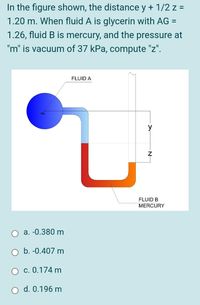
Structural Analysis
6th Edition
ISBN: 9781337630931
Author: KASSIMALI, Aslam.
Publisher: Cengage,
expand_more
expand_more
format_list_bulleted
Concept explainers
Question

Transcribed Image Text:In the figure shown, the distance y + 1/2 z =
1.20 m. When fluid A is glycerin with AG =
1.26, fluid B is mercury, and the pressure at
"m" is vacuum of 37 kPa, compute "z".
FLUID A
FLUID B
MERCURY
a. -0.380 m
b. -0.407 m
c. 0.174 m
O d. 0.196 m
Expert Solution
This question has been solved!
Explore an expertly crafted, step-by-step solution for a thorough understanding of key concepts.
Step by stepSolved in 2 steps with 1 images

Knowledge Booster
Learn more about
Need a deep-dive on the concept behind this application? Look no further. Learn more about this topic, civil-engineering and related others by exploring similar questions and additional content below.Similar questions
- In the inclined manometer shown in the figure below, the reservoir is large. Its surface may be assumed to remain at a fixed elevation. A is connected to a gas pipeline and the deflection noted on the inclined glass tube is 100 mm. Assuming q = 30° and the manometric fluid as oil with specific gravity of 0.86, the pressure at A is A 100 mm Ꮎ Barrow_forwardThe gage pressure of the air in the tank shown in figure is measured to be 65 kPa. Determine the differential heighth of the mercury column. 65KPA Oil ŚG = 0.72 75cm Air Water Mercury SG - 13.6 30cmarrow_forward1.) A pressure in a given tank reads 398 mm of Hg. Determine the equivalent height of a certain fluid in m with sp.gr= 4.33.arrow_forward
- Given The tank shown has one curved surface restraining a body of static fluid, with the following dimensions: w- 5.00 m h1 = 2.5 m R1 = 0.85 m Required Determine the value of x-bar in metres, to the nearest 1000th. Water hl R1arrow_forwardThe Newtonian fluid shown in is confined between the plate and a fixed surface as shown in (Figure 1). Its velocity profile is defined by u = (8y-0.3y2) mm/s, where y is in mm. The plate has a surface area of 29(10³) mm² in contact with the fluid. Take μ = 0.482 N. s/m². Suppose that h = 6 mm. Figure h < 1 of 1 Part A Determine the force P that must be applied to the plate to cause this motion. Express your answer to three significant figures and include the appropriate units. xa P= 67.1 μA Xb a b X.10n < Return to Assignment mN Submit Previous Answers Request Answer X Incorrect; Try Again; 2 attempts remaining ? Provide Feedbackarrow_forwardIn the figure shown, the distance y + 1/2 z = 1.20 m. When fluid A is water, fluid B is mercury, and the pressure at "m" is vacuum of 37 kPa, compute "z". FLUID A y FLUID B MERCURY a. -0.380 m O b. -0.407 m c. 0.174 m d. 0.196 marrow_forward
arrow_back_ios
arrow_forward_ios
Recommended textbooks for you

 Structural Analysis (10th Edition)Civil EngineeringISBN:9780134610672Author:Russell C. HibbelerPublisher:PEARSON
Structural Analysis (10th Edition)Civil EngineeringISBN:9780134610672Author:Russell C. HibbelerPublisher:PEARSON Principles of Foundation Engineering (MindTap Cou...Civil EngineeringISBN:9781337705028Author:Braja M. Das, Nagaratnam SivakuganPublisher:Cengage Learning
Principles of Foundation Engineering (MindTap Cou...Civil EngineeringISBN:9781337705028Author:Braja M. Das, Nagaratnam SivakuganPublisher:Cengage Learning Fundamentals of Structural AnalysisCivil EngineeringISBN:9780073398006Author:Kenneth M. Leet Emeritus, Chia-Ming Uang, Joel LanningPublisher:McGraw-Hill Education
Fundamentals of Structural AnalysisCivil EngineeringISBN:9780073398006Author:Kenneth M. Leet Emeritus, Chia-Ming Uang, Joel LanningPublisher:McGraw-Hill Education
 Traffic and Highway EngineeringCivil EngineeringISBN:9781305156241Author:Garber, Nicholas J.Publisher:Cengage Learning
Traffic and Highway EngineeringCivil EngineeringISBN:9781305156241Author:Garber, Nicholas J.Publisher:Cengage Learning


Structural Analysis (10th Edition)
Civil Engineering
ISBN:9780134610672
Author:Russell C. Hibbeler
Publisher:PEARSON

Principles of Foundation Engineering (MindTap Cou...
Civil Engineering
ISBN:9781337705028
Author:Braja M. Das, Nagaratnam Sivakugan
Publisher:Cengage Learning

Fundamentals of Structural Analysis
Civil Engineering
ISBN:9780073398006
Author:Kenneth M. Leet Emeritus, Chia-Ming Uang, Joel Lanning
Publisher:McGraw-Hill Education


Traffic and Highway Engineering
Civil Engineering
ISBN:9781305156241
Author:Garber, Nicholas J.
Publisher:Cengage Learning